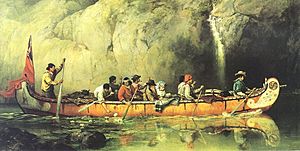Rabaska facts for kids
A rabaska is a very large canoe originally made from tree bark. It was first used by the Algonquin people in North America. Sometimes it's also called a Maître canoe (which means "master canoe" in French).
These big canoes were super important for French and Canadian explorers in the 1600s and 1700s. They helped people travel deep into North America. Later, traders and other travelers used them until the late 1800s. Rabaskas helped people explore new lands and connect with the Indigenous peoples living there.
What's in a Name?
The word rabaska is a special word from Canada. It comes from New France, which was an old French colony. The word comes from athapaskaw. This word is found in both the Algonquin and Cree languages. It refers to the Athabasca River. The original meaning of athapaskaw is "grass and reeds here and there."
How Big Are They?
Rabaskas are really impressive in size! They are usually about 10 meters (33 feet) long. They are also about 1.5 meters (5 feet) wide. A rabaska can carry ten adults and a lot of cargo. Even empty, a rabaska weighs about 150 kilograms (330 pounds).
For fun or sport, a rabaska usually has a crew of twelve paddlers. They sit in six rows, with two people per row. There's also a cox at the back. The cox steers the canoe.
Rabaskas are known for being fast and strong. But they also sit quite deep in the water. This means they can get stuck in shallow areas. If that happens, the paddlers at the front quickly jump out. They help push the canoe free to prevent damage.
Rabaskas in the Past
Indigenous peoples used rabaskas for many things. They traveled, traded goods, and found new places to live. Fur traders especially loved rabaskas. This was because the canoes could carry huge amounts of furs. They also delivered supplies to distant trading posts.
Every spring, many rabaska canoes would leave Lachine, near Montreal. They had experienced crews. They would travel to the "Pays d'en Haut," which means "Upper Country." This was a long journey to find valuable furs. They would not return until autumn.
Because rabaskas were so strong, they helped explorers reach far-off places. These places were hard to get to by other ways. Some crews even hired singers. The singers would help the paddlers keep a good rhythm. This helped them paddle faster and work harder!
Rabaskas Today

Today, rabaskas are used for outdoor fun. They are a great way to enjoy nature. Since they are so stable and have a large crew, people can relax. They can take breaks and enjoy the scenery.
Rabaskas are also popular in sports. In Quebec, Canada, there's a big competition every August. It's called the "Mauricie International Canoe Classic." All the rabaska teams compete there. This race lasts three days. It takes place on the Saint-Maurice River. The race covers almost 200 kilometers (124 miles). It goes from La Tuque all the way to Trois-Rivières.


